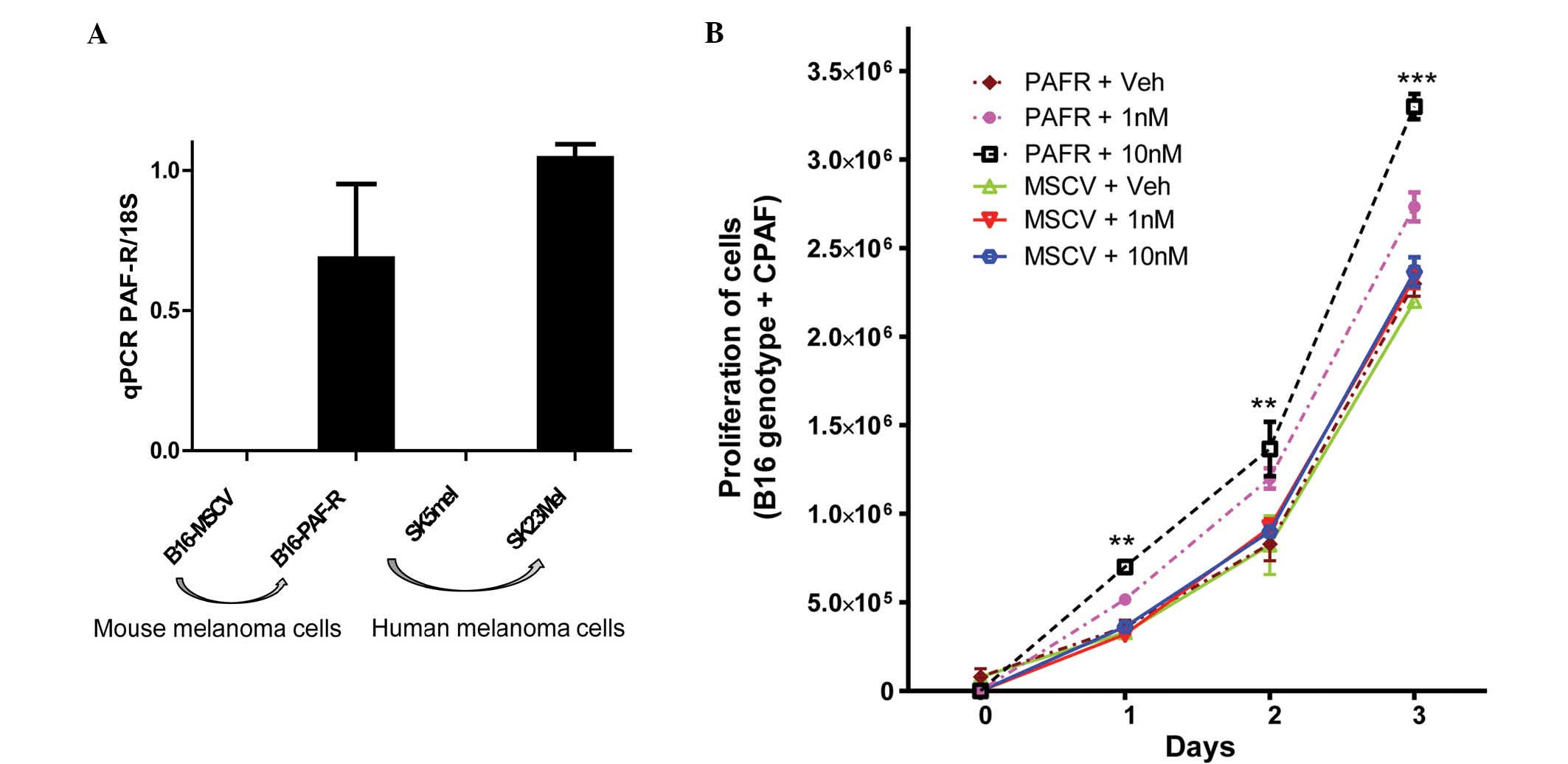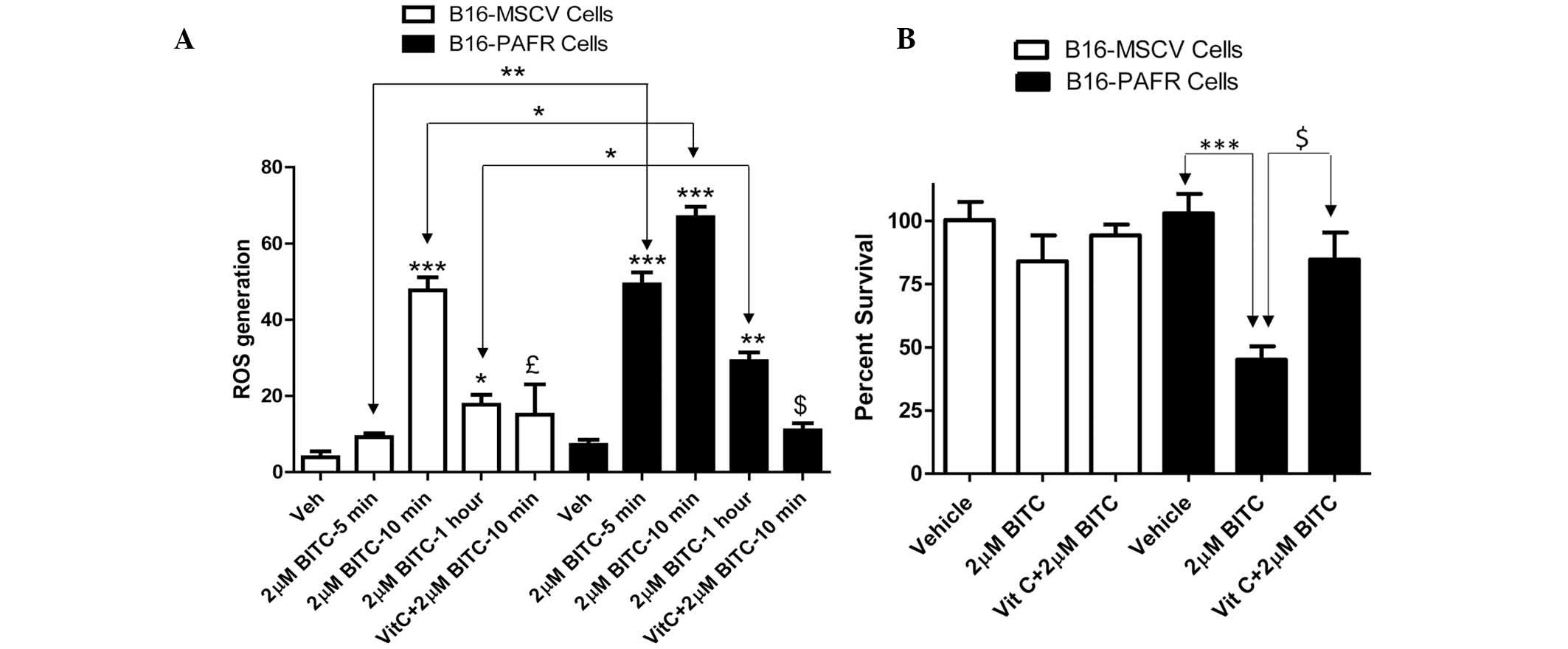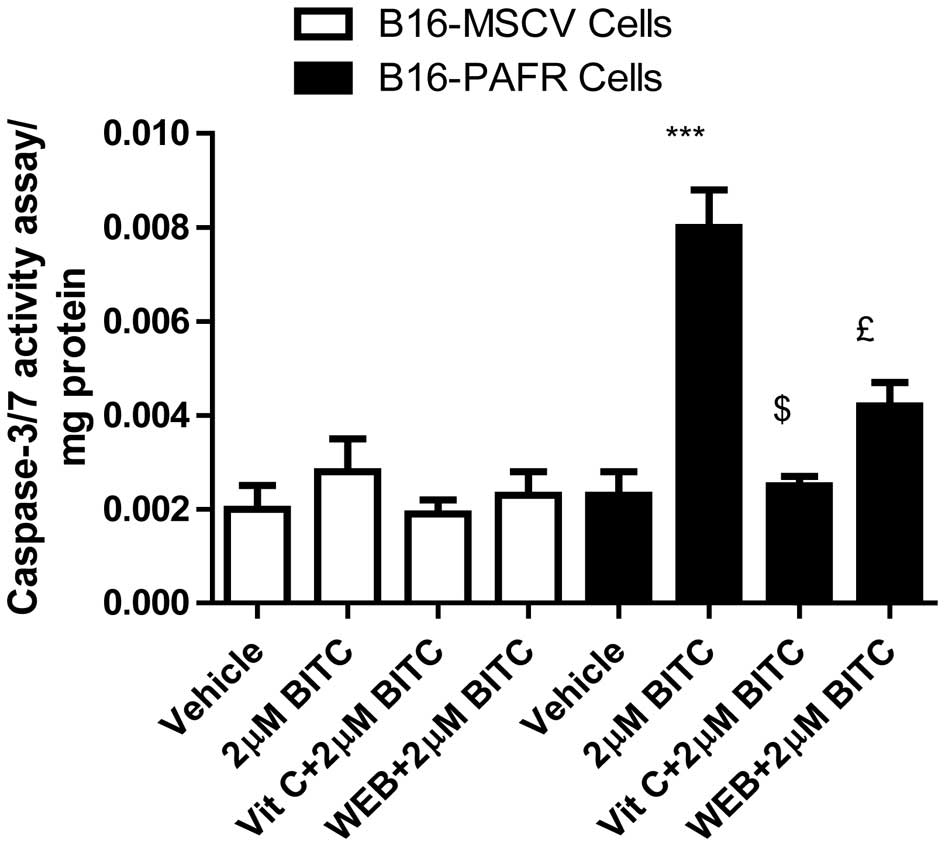|
1
|
Miller AJ and Mihm MC Jr: Melanoma. N Engl
J Med. 355:51–65. 2006. View Article : Google Scholar : PubMed/NCBI
|
|
2
|
National Cancer Institute: SEER Stat Fact
Sheets: Melanoma of the Skin. http://seer.cancer.gov/statfacts/html/melan.html.
Accessed January 21, 2015.
|
|
3
|
Ishii S, Nagase T and Shimizu T:
Platelet-activating factor receptor. Prostaglandins Other Lipid
Mediat. 68:599–609. 2002. View Article : Google Scholar : PubMed/NCBI
|
|
4
|
Zhuang Q, Bastien Y and Mazer BD:
Activation via multiple signaling pathways induces down-regulation
of platelet-activating factor receptors on human B lymphocytes. J
Immunol. 165:2423–2431. 2000. View Article : Google Scholar : PubMed/NCBI
|
|
5
|
Travers JB, Huff JC, Rola-Pleszczynski M,
Gelfand EW, Morelli JG and Murphy RC: Identification of functional
platelet-activating factor receptors on human keratinocytes. J
Invest Dermatol. 105:816–823. 1995. View Article : Google Scholar : PubMed/NCBI
|
|
6
|
Sahu RP, Kozman AA, Yao Y, DaSilva SC,
Rezania S, Martel KC, Warren SJ, Travers JB and Konger RL: Loss of
the platelet activating factor receptor in mice augments
PMA-induced inflammation and cutaneous chemical carcinogenesis.
Carcinogenesis. 33:694–701. 2012. View Article : Google Scholar : PubMed/NCBI
|
|
7
|
Sahu RP, Petrache I, Van Demark MJ, Rashid
BM, Ocana JA, Tang Y, Yi Q, Turner MJ, Konger RL and Travers JB:
Cigarette smoke exposure inhibits contact hypersensitivity via the
generation of platelet-activating factor agonists. J Immunol.
190:2447–2454. 2013. View Article : Google Scholar : PubMed/NCBI
|
|
8
|
Hackler PC, Reuss S, Konger RL, Travers JB
and Sahu RP: Systemic platelet-activating factor receptor
activation augments experimental lung tumor growth and metastasis.
Cancer Growth Metastasis. 19:27–32. 2014.
|
|
9
|
Melnikova VO, Mourad-Zeidan AA, Lev DC and
Bar-Eli M: Platelet-activating factor mediates MMP-2 expression and
activation via phosphorylation of cAMP-response element-binding
protein and contributes to melanoma metastasis. J Biol Chem.
281:2911–2922. 2006. View Article : Google Scholar
|
|
10
|
Heon Seo K, Ko HM, Kim HA, Choi JH, Jun
Park S, Kim KJ, Lee HK and Im SY: Platelet-activating factor
induces upregulation of antiapoptotic factors in a melanoma cell
line through nuclear factor-kappaB activation. Cancer Res.
66:4681–4686. 2006. View Article : Google Scholar : PubMed/NCBI
|
|
11
|
Biancone L, Cantaluppi V, Del Sorbo L,
Russo S, Tjoelker LW and Camussi G: Platelet-activating factor
inactivation by local expression of platelet-activating factor
acetyl-hydrolase modifies tumor vascularization and growth. Clin
Cancer Res. 9:4214–4220. 2003.PubMed/NCBI
|
|
12
|
de Oliveira SI, Andrade LN, Onuchic AC,
Nonogaki S, Fernandes PD, Pinheiro MC, Rohde CB, Chammas R and
Jancar S: Platelet-activating factor receptor (PAF-R)-dependent
pathways control tumour growth and tumour response to chemotherapy.
BMC Cancer. 10:2002010. View Article : Google Scholar : PubMed/NCBI
|
|
13
|
Sahu RP, Turner MJ, DaSilva SC, Rashid BM,
Ocana JA, Perkins SM, Konger RL, Touloukian CE, Kaplan MH and
Travers JB: The environmental stressor ultraviolet B radiation
inhibits murine antitumor immunity through its ability to generate
platelet-activating factor agonists. Carcinogenesis. 33:1360–1367.
2012. View Article : Google Scholar : PubMed/NCBI
|
|
14
|
Barber LA, Spandau DF, Rathman SC, Murphy
RC, Johnson CA, Kelley SW, Hurwitz SA and Travers JB: Expression of
the platelet-activating factor receptor results in enhanced
ultraviolet B radiation-induced apoptosis in a human epidermal cell
line. J Biol Chem. 273:18891–18897. 1998. View Article : Google Scholar : PubMed/NCBI
|
|
15
|
Li T, Southall MD, Yi Q, Pei Y, Lewis D,
Al-Hassani M, Spandau D and Travers JB: The epidermal
platelet-activating factor receptor augments chemotherapy-induced
apoptosis in human carcinoma cell lines. J Biol Chem.
278:16614–16621. 2003. View Article : Google Scholar : PubMed/NCBI
|
|
16
|
Jilaveanu LB, Aziz SA and Kluger HM:
Chemotherapy and biologic therapies for melanoma: Do they work?
Clin Dermatol. 27:614–625. 2009. View Article : Google Scholar : PubMed/NCBI
|
|
17
|
Block G, Patterson B and Subar A: Fruit,
vegetables and cancer prevention: A review of the epidemiological
evidence. Nutr Cancer. 18:1–29. 1992. View Article : Google Scholar
|
|
18
|
Stoner GD and Morse MA: Isothiocyanates
and plant polyphenols as inhibitors of lung and esophageal cancer.
Cancer Lett. 114:113–119. 1997. View Article : Google Scholar : PubMed/NCBI
|
|
19
|
Sahu RP and Srivastava SK: The role of
STAT-3 in the induction of apoptosis in pancreatic cancer cells by
benzyl isothiocyanate. J Natl Cancer Inst. 101:176–193. 2009.
View Article : Google Scholar : PubMed/NCBI
|
|
20
|
Warin R, Xiao D, Arlotti JA, Bommareddy A
and Singh SV: Inhibition of human breast cancer xenograft growth by
cruciferous vegetable constituent benzyl isothiocyanate. Mol
Carcinog. 49:500–507. 2010. View
Article : Google Scholar : PubMed/NCBI
|
|
21
|
Wu CL, Huang AC, Yang JS, Liao CL, Lu HF,
Chou ST, Ma CY, Hsia TC, Ko YC and Chung JG: Benzyl isothiocyanate
(BITC) and phenethyl isothiocyanate (PEITC)-mediated generation of
reactive oxygen species causes cell cycle arrest and induces
apoptosis via activation of caspase-3, mitochondria dysfunction and
nitric oxide (NO) in human osteogenic sarcoma U-2 OS cells. J
Orthop Res. 29:1199–1209. 2011. View Article : Google Scholar : PubMed/NCBI
|
|
22
|
Wu X, Zhu Y, Yan H, Liu B, Li Y, Zhou Q
and Xu K: Isothiocyanates induce oxidative stress and suppress the
metastasis potential of human non-small cell lung cancer cells. BMC
Cancer. 10:2692010. View Article : Google Scholar : PubMed/NCBI
|
|
23
|
Ni WY, Hsiao YP, Hsu SC, Hsueh SC, Chang
CH, Ji BC, Yang JS, Lu HF and Chung JG: Oral administration of
benzyl-isothiocyanate inhibits in vivo growth of subcutaneous
xenograft tumors of human malignant melanoma A375.S2 cells. In
Vivo. 27:623–626. 2013.PubMed/NCBI
|
|
24
|
Huang SH, Wu LW, Huang AC, Yu CC, Lien JC,
Huang YP, Yang JS, Yang JH, Hsiao YP, Wood WG, Yu CS and Chung JG:
Benzyl isothiocyanate (BITC) induces G2/M phase arrest and
apoptosis in human melanoma A375.S2 cells through reactive oxygen
species (ROS) and both mitochondria-dependent and death
receptor-mediated multiple signaling pathways. J Agric Food Chem.
60:665–675. 2012. View Article : Google Scholar
|
|
25
|
Thejass P and Kuttan G: Allyl
isothiocyanate (AITC) and phenyl isothiocyanate (PITC) inhibit
tumour-specific angiogenesis by downregulating nitric oxide (NO)
and tumour necrosis factor-alpha (TNF-alpha) production. Nitric
Oxide. 16:247–257. 2007. View Article : Google Scholar
|
|
26
|
Manesh C and Kuttan G: Effect of naturally
occurring allyl and phenyl isothiocyanates in the inhibition of
experimental pulmonary metastasis induced by B16F-10 melanoma
cells. Fitoterapia. 74:355–363. 2003. View Article : Google Scholar : PubMed/NCBI
|
|
27
|
Hamsa TP, Thejass P and Kuttan G:
Induction of apoptosis by sulforaphane in highly metastatic B16F-10
melanoma cells. Drug Chem Toxicol. 34:332–340. 2011. View Article : Google Scholar : PubMed/NCBI
|
|
28
|
Sahu RP, DaSilva SC, Rashid B, Martel KC,
Jernigan D, Mehta SR, Mohamed DR, Rezania S, Bradish JR, Armstrong
AB, Warren S and Konger RL: Mice lacking epidermal PPARγ exhibit a
marked augmentation in photocarcinogenesis associated with
increased UVB-induced apoptosis, inflammation and barrier
dysfunction. Int J Cancer. 131:E1055–E1066. 2012. View Article : Google Scholar : PubMed/NCBI
|
|
29
|
Sharma A, Sharma AK, Madhunapantula SV,
Desai D, Huh SJ, Mosca P, Amin S and Robertson GP: Targeting Akt3
signaling in malignant melanoma using isoselenocyanates. Clin
Cancer Res. 15:1674–1685. 2009. View Article : Google Scholar : PubMed/NCBI
|
|
30
|
Sahu RP, Zhang R, Batra S, Shi Y and
Srivastava SK: Benzyl isothiocyanate-mediated generation of
reactive oxygen species causes cell cycle arrest and induces
apoptosis via activation of MAPK in human pancreatic cancer cells.
Carcinogenesis. 30:1744–1753. 2009. View Article : Google Scholar : PubMed/NCBI
|
|
31
|
Xiao D, Powolny AA and Singh SV: Benzyl
isothiocyanate targets mitochondrial respiratory chain to trigger
reactive oxygen species-dependent apoptosis in human breast cancer
cells. J Biol Chem. 283:30151–30163. 2008. View Article : Google Scholar : PubMed/NCBI
|
|
32
|
Miyoshi N, Watanabe E, Osawa T, Okuhira M,
Murata Y, Ohshima H and Nakamura Y: ATP depletion alters the mode
of cell death induced by benzyl isothiocyanate. Biochim Biophys
Acta. 1782:566–573. 2008. View Article : Google Scholar : PubMed/NCBI
|
|
33
|
Doroshow JH: Redox modulation of
chemotherapy-induced tumor cell killing and normal tissue toxicity.
J Natl Cancer Inst. 98:223–235. 2006. View Article : Google Scholar : PubMed/NCBI
|
|
34
|
Huang CS, Lin AH, Liu CT, Tsai CW, Chang
IS, Chen HW and Lii CK: Isothiocyanates protect against oxidized
LDL-induced endothelial dysfunction by upregulating Nrf2-dependent
antioxidation and suppressing NFκB activation. Mol Nutr Food Res.
57:1918–1930. 2013. View Article : Google Scholar : PubMed/NCBI
|
|
35
|
Miyoshi N, Takabayashi S, Osawa T and
Nakamura Y: Benzyl isothiocyanate inhibits excessive superoxide
generation in inflammatory leukocytes: implication for prevention
against inflammation-related carcinogenesis. Carcinogenesis.
25:567–575. 2004. View Article : Google Scholar
|
|
36
|
Marques SA, Dy LC, Southall MD, Yi Q,
Smietana E, Kapur R, Marques M, Travers JB and Spandau DF: The
platelet-activating factor receptor activates the extracellular
signal-regulated kinase mitogen-activated protein kinase and
induces proliferation of epidermal cells through an epidermal
growth factor-receptor-dependent pathway. J Pharmacol Exp Ther.
300:1026–1035. 2002. View Article : Google Scholar : PubMed/NCBI
|
|
37
|
Brandmaier AG, Leitner WW, Ha SP, Sidney
J, Restifo NP and Touloukian CE: High-avidity autoreactive CD4+ T
cells induce host CTL, overcome T(regs) and mediate tumor
destruction. J Immunother. 32:677–688. 2009. View Article : Google Scholar : PubMed/NCBI
|













